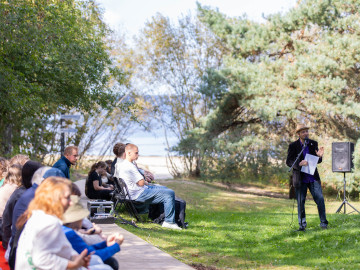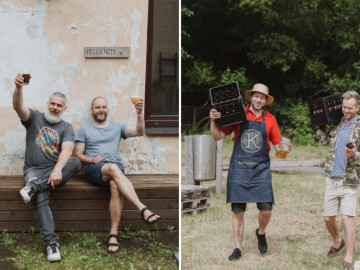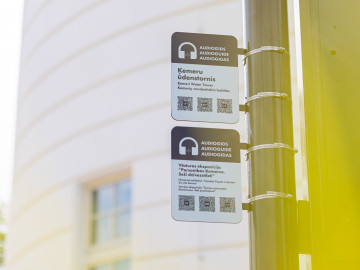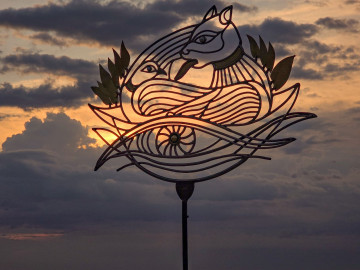Summer in Jūrmala’s Exhibition Halls
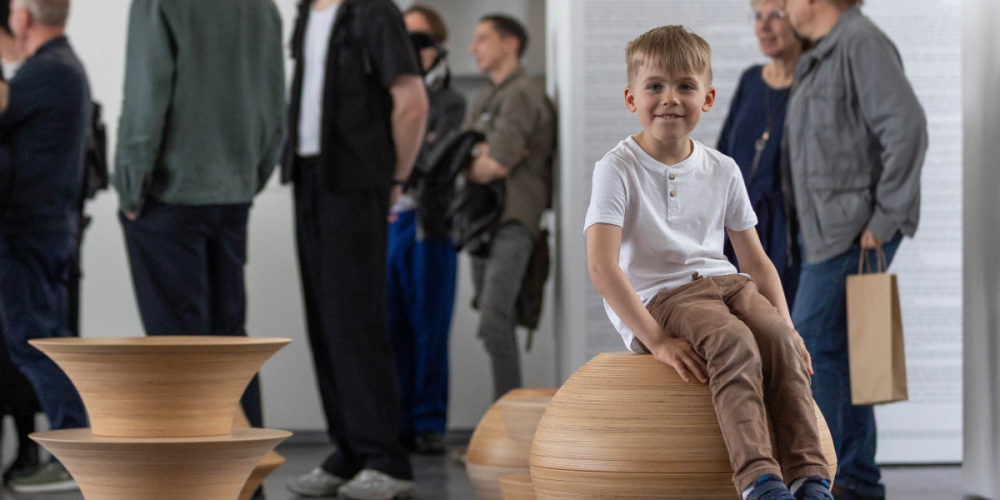
Summer is when Jūrmala’s cultural spaces become a parallel world – a place to enrich the mind and spirit in a season full of vitality and sunlight. The summer exhibition programme features classical and contemporary art, as well as special sections dedicated to exploring history. Discover the season’s cultural highlights!

Džemma Skulme. Model with a Ball. 1968–2008. Zuzeum Collection. Photo: Jānis Pipars
Jūrmala Museum / Jūrmalas muzejs (Tirgoņu Street 29, Majori)
-
View in the Mirror (Skats spogulī) (04.07.–07.09.) – an exhibition marking the centenary of Džemma Skulme (1925–2019), highlighting her remarkable ability to evolve, retain a contemporary perspective, and remain faithful to her distinctive artistic style. The display also reflects her family lineage – shown alongside the artist’s works are pieces by her parents, Marta Liepiņa-Skulme and Oto Skulme, and childhood drawings by her daughter Marta Skulme, which served as inspiration. The exhibition asks: how can we transform, renew, and grow? Skulme’s example proves that creativity knows no age – it is the continuation of thought through freedom.

Aigars Bikše. Maija Borovkova’s Enlightenment in Ziepniekkalns, Two Years Before Her Conversion to Islam, Birmingham, 2018. Collection of Edgars and Katrīna Jaunups
-
Magnetism (Magnētisms) (04.07.–07.09.) – a contemporary art exhibition conceived as a network of invisible threads connecting artworks, historical objects, facts, and memories. Inspired by Carl Gustav Jung’s concept of “synchronicity”, the exhibition invites visitors into a subtle, intuitive and contextual experience where art attracts, provokes, and resonates. Artworks and artefacts from museums and private collections are interwoven like magnetic filaments linking emotions with the imprint of time.

"Jūrmala – 65" – an open-air exhibition in Horn's Garden. Photo: Jūrmala City Municipality
Bulduri Square / Bulduru skvērs (near Bulduri Station)
-
“Jūrmala – 65” – An open-air exhibition, presenting a photographic retrospective of the city's development. This exhibition complements the one at Jūrmala Museum, celebrating Jūrmala's 65th anniversary.

Jana Vilus
Jūrmala Culture Centre (Jomas Street 35, Majori)
- “… and the colours remain” (“... un krāsas paliek”) (01.08–20.09) – an exhibition in which artist Jana Vilus, a person on the autism spectrum, reveals her world – a moment of breath, a moment of a smile, a moment of special atmosphere. A client of the multifunctional centre “Atver durvis Betānijā”, Vilus is the author of 33 solo exhibitions and a laureate of an international competition. However, her greatest fulfilment lies in the fact that people can feel the message her heart wishes to convey through her works. The exhibition is on view at the Jūrmala Culture Centre. Free admission.

Eduards Metuzāls, 1919
Aspazija House / Aspazijas māja (Z. Meierovics Avenue 18–20, Dubulti)
-
“Metuzāls. From Switzerland to Jūrmala” (until 27.09.) – the exhibition features works by painter Eduards Metuzāls, capturing Swiss alpine landscapes and the atmosphere of Rīgas Jūrmala. The paintings were created during his time in Switzerland, when he developed a close friendship with Rainis and Aspazija. The show presents a previously unexhibited collection of works held by the artist’s family.

Diāna Janušone, “Time that Disrupts Structures”, 2025 (mixed media, wood shavings, wire)
Bulduri Exhibition Hall / Bulduru Izstāžu nams (Muižas Street 6, Bulduri)
-
In Time that Disrupts Structures (09.07–07.09), textile artist Diāna Janušone explores space and the human body as carriers of transience and layered memories. Tufting, wool felting, and sublimation printing serve as tools for a visual meditation on fragility and loss. Poetically transformed documentary fragments and architectural elements form a silent dialogue with the viewer – an invitation to look inward, to sense the passage of time and the human presence in landscape, architecture, and the body itself.
-
A chance to explore the art legend of Jūrmala – the studio and creative world of the outstanding Latvian landscape painter Valdis Bušs (1924–2014).
Art Station Dubulti / Mākslas stacija Dubulti (Z. Meierovics Avenue 3, Dubulti)
- Kristaps Ancāns & Pauls Rietums. “Literally a Very Small Celebration” (06.06.–15.09.2025) - the exhibition marks the 10th anniversary of Art Station Dubulti, highlighting the interplay between contemporary art and public infrastructure. At the core of the exhibition are proto-industrial modular systems, developed in collaboration with Latvijas Finieris, Troja, and IGLU Soft Play. After the exhibition, some of these modules will remain in the station’s public waiting area, leaving a lasting and functional legacy.

Gallery Bastejs / Galerija Bastejs (Skultes Street 10, Priedaine)
- HEILIGE STUNDE / SACRED HOUR (01.08.–30.09.) – an exhibition where Kristians Brekte creates a visual dialogue with the works of Swiss Symbolist Ferdinand Hodler (1853–1918), overpainting his reproductions as a contemporary commentary on aesthetics, death, and hidden anxiety. Hodler’s sacred compositions become backdrops for grotesque, sexuality, and post-symbolist drama – Brekte poses the question: what is a “sacred hour” in a world ruled by chaos, deconstruction, and fear of tomorrow? Ink strokes, occult references, and symbols filled with dark irony transform classical art into something alive and still provocatively relevant.

Dzintari Beach near Turaidas Street
Art Beach. The Journey (Mākslas liedags. Ceļojums) (11.07. – 7.09.) – also this summer, Jūrmala’s beach turns into an open-air exhibition space — from 11 July to 7 September, an open-air exhibition Art Beach. The Journey (Mākslas liedags. Ceļojums) will take place at Dzintari Beach near Turaidas Street, featuring sculptures and objects from Latvia, Lithuania and the Czech Republic. The sculptures integrated into the coastal landscape create a dialogue between the seaside environment and the artists’ stories of a journey, both internal and spatial. Visitors are invited to take a leisurely walk, immersing themselves in the diversity of materials, the play of forms, and the language of symbols. Participating artists: Roberts Diners, Lilija Dinere, Matiass Jansons, Aneta Jukličková (Czech Republic), Mārtiņš Daksis, Andris Loss, Kėstutis Benedikas (Lithuania), Artūrs Bogdanovs. Curator: Lilija Dinere.

“Mare Balticum” by French artist Jean Denant, 2025. Photo: Jūrmala City Municipality
New Environmental Object On Dzintari Beach
A new contemporary environmental artwork has been unveiled on Dzintari Beach near Turaidas Street – a mirror-map “Mare Balticum” by French artist Jean Denant. Made of polished stainless steel, the artwork reflects the shimmering sea, sky, sandy beach, and the viewer’s silhouette. It symbolizes unity among the Baltic Sea nations and highlights the importance of environmental sustainability. Jūrmala is the first of eight coastal cities where the work will be installed.
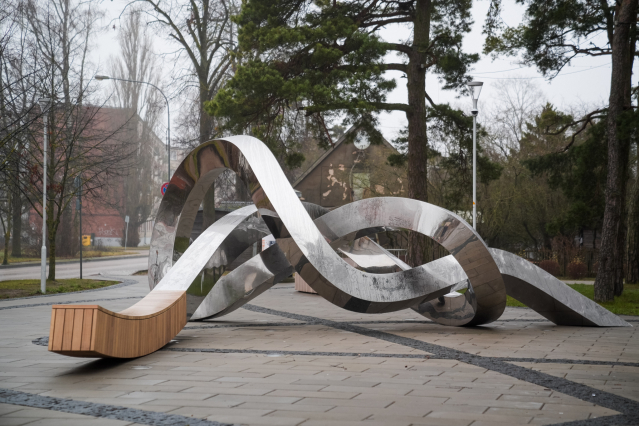
U. Traumanis. Environmental object "Knot", 2024. Photo: Jūrmala City Municipality
New Environmental Object in Kauguri Square
In addition to the diverse exhibitions in the halls, visitors are invited to discover a newly created piece of urban art in Kauguri Square – the environmental object “Mezgls” (Knot) by Uģis Traumanis (realized by SIA MetalProjekts and DJA – Didzis Jaunzems Architecture). The object symbolizes unity and references the history of the Kauguri fishing village, where knot-tying was an essential skill. The mirror-smooth, hand-polished surface reflects the surroundings – apartment blocks, historical buildings, a Catholic church, pine trees, and Jūrmala’s ever-changing skies.

